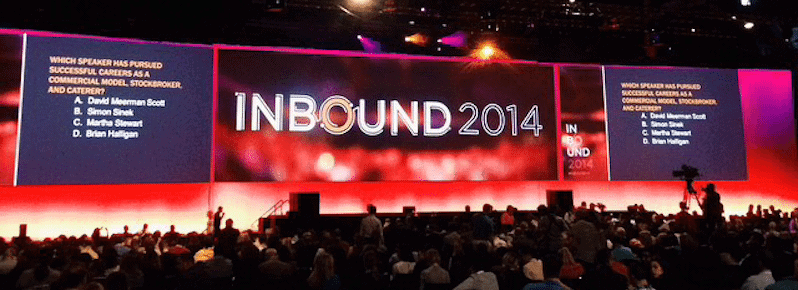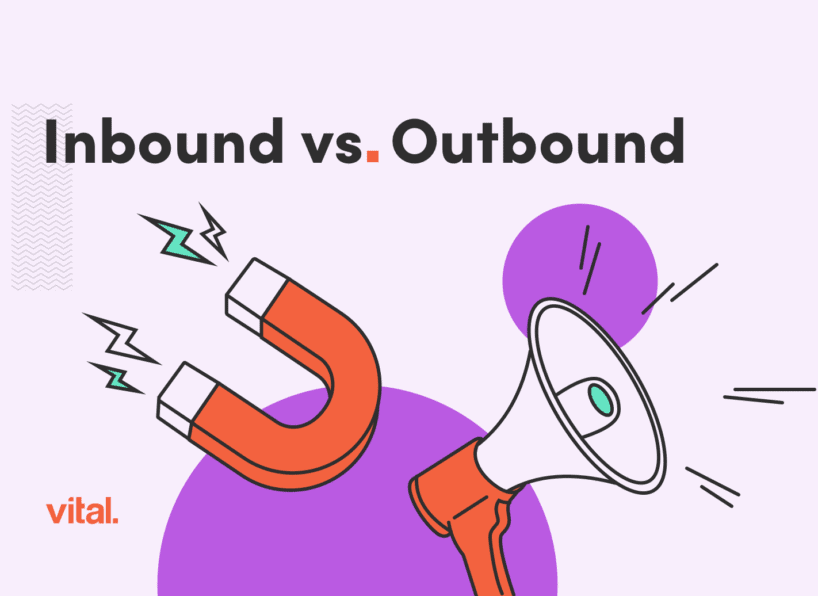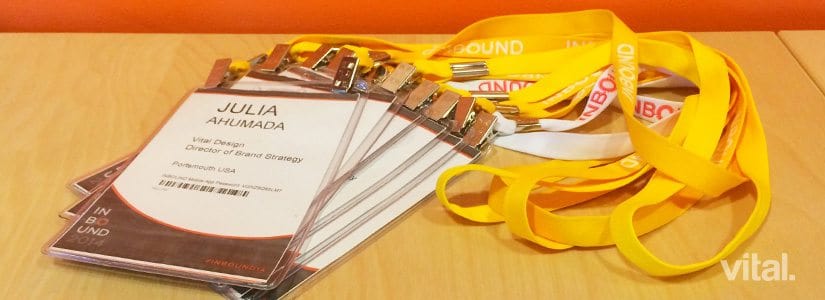Sales, Innovation and Community: Key Takeaways of #INBOUND14.
It was another great year to attend the annual HubSpot inbound marketing conference in Boston. We sent several Vitalians—both in and out of our inbound marketing department—to take part in a week’s worth of inspiration from some of the biggest thought leaders in the industry.
After the conference, our team returned to the Portsmouth office determined to apply the latest and greatest of inbound marketing trends to our everyday practices. Conferences, like HubSpot’s #INBOUND14, are perfect for staying current with trends, networking with others and jumpstarting creativity. But more important than actually attending these types of events, is what you choose to do afterwards. Inspiring ideas are useless without the proper reflection to follow. So as any good inbound marketing agency would, we got together for a post-conference debrief.
For so many people that all attended the same conference—and some of the same sessions—we had SO many big ideas worth sharing and implementing into our own inbound strategies.
There’s no way to briefly cover them all, but here are a few of our inbound marketing team’s top #INBOUND14 takeaways:
Doug Ridley— Director of Content Marketing & Social Media
Hey sales, can we be friends already?
One of the most covered themes at #INBOUND14 was the intertwining of marketing and sales. While there used to be a distinction between the two, they now work closer together than ever before. In all reality, these two departments—known for butting heads occasionally frequently—depend on one another. And as inbound marketers, our success depends on this functioning relationship. At #INBOUND14, we were challenged to ask ourselves:
How can inbound support sales?
There isn’t necessarily a right answer to this, but we think that it’s an important question to consider when developing inbound strategies. At Vital, we find ourselves working with clients on items that go beyond marketing. No longer can inbound marketers just hand off content and call it a day; the process involves mutual understanding, inter-departmental teamwork and even some consultation.
The speakers at #INBOUND14 all echoed each other in relaying this message, so it really stuck. If you weren’t there this year, take a minute to reflect—how do these relationships function at your organization?
Chuck McMahon— Content Manager
Get to the next curve.
Guy Kawasaki’s keynote kicked-off Inbound in a big way. One of the trends that stood out to Chuck, was the message Kawasaki delivered on what it means to really be innovative. Kawasaki said that,
“If you want to truly be innovative & revolutionary, you don’t change what you’re doing now, you get to the next curve.”
It’s not uncommon to get bogged down in the process of trying to find a solution to a particular problem. While most people try hard to improve the things that we already have, innovation, according to Kawasaki, is when we get to the next curve. How did we go from ice farming to in-house refrigeration? Or from horse and buggy to the automobile? Naturally, we try to make things stronger and faster, but in each of those historical cases something entirely new was created. Kawasaki’s message taught us to go one, two or even three steps further to jump to the next curve. Sometimes the solution is the next curve itself, not necessarily the solution to the original problem you’re trying to solve.
Crystal Paradis— Content Strategist & Copywriter
Innovation waits for no one . . . and you shouldn’t wait for it.
If there was one thing that was drilled into us at #INBOUND14, it’s that we need to be innovative. Speakers across the board told us that we need to go out into the world and do something crazy; something that has never been done before but will take the current status quo to levels we hadn’t even ever imagined.
Okay, so we know what you’re thinking—Well yeah, obviously we want to be innovative. This isn’t news. As obvious as it may be though, it’s something that we all struggle with. So what can you do to be innovative?
In our #INBOUND14 recap meeting, Crystal provided this great abridged version of the Malcom McLean story. McLean was transport entrepreneur known for revolutionizing the trade industry. Malcolm Gladwell used McLean to highlight innovation in his keynote.
The Story of Malcom McLean:
Workers go on strike—fine whatevs. I’ll use this downtime to re-think the process.
I’m going to need new cranes.
Dear shipping crane companies, can you make one that can lift a 40’ container? And in 90 days.
– Uh, no.
Fine, I don’t need a crane for shipping.
Just need a crane that lifts heavy things.
McLean to the lumber industry: Can haz?
– Sure.
In 90 days?
– … sort of.
Done. Gots me a crane.
“In order to be the transformative innovator he was, he was unwilling to wait.”
Gladwell and a number of other speakers conveyed to us the dire importance of thinking outside of the box that we generally function within. For McLean, that meant finding resources in another industry. For inbound marketers, it may mean utilizing other outlets in non-traditional ways to reach targeted audiences.
Alex Shaffer— Project Manager & Copywriter
We need to be more like KISS.
With companies continually racing to beat others in their industries, the speakers at #INBOUND14 reminded us that we can’t get caught up with what others are doing. We need to keep up, yes. But copy, no. One-upping versions of our competitors’ products and services is not classified as innovation.
This also holds true when others are copying your great work—don’t allow yourself to become consumed by it. In a session with Ian Fitzpatrick and Patrick Cassidy, we were challenged to be more like KISS. Yes, KISS, the hard rock band well known for its’ face paint and stage outfits. The band actually encourages fans to copy their brand—concertgoers wear their t-shirts, dress like them, pose for and post photos of themselves in costume. They essentially mock the band as affectionately as possible. KISS has whole-heartedly embraced a phenomenon that would cause a bit of a legal scuffle almost anywhere else.
As many of #INBOUND14’s speakers noted, being copied is really the best kind of compliment that you could receive. By keeping our heads on straight and recognizing the compliment, we are empowered to push onto the next big thing. If you’re as lucky as KISS, you’ll have a strong, loyal community standing behind your brand.And that’s what it’s all about, right?
Chris Getman— Director of Inbound
Insight is different than data.
Your data shows positive trends, so what? Collectively as inbound marketers, we tend to get really excited by upward facing lines and charts, but tell me . . .
What does it actually mean?
For Chris, our Director of Inbound, #INBOUND14 reinforced the notion that our success is reliant not on data, but pure insight. Data is good for showing clients that we’re able to deliver the inbound results that they expect from us, but that’s not what’s important. Site traffic, interactions on social, and conversion rates could all increase exponentially, but how have those directly impacted revenue? This is the insight that your clients want from you. And in cases where your inbound successes aren’t translating to success on the sales team, insight is understanding your clients process enough to be able to help them source that disconnect. Because really, as inbound marketers we’re writing business plans disguised as marketing.
Halie Olszowy— Social Media Assistant . . . That’s me!
Inbound is about building community.
As inbound marketers, ultimately driven by the revenue goals that we work with sales to meet, I think that it is easy to lose sight of what we actually do. Yes, we write copy, tweet, analyze and all of the other inbound-esque tasks that come with the territory. But above all else, inbound is about community.
As different as my sessions were from one another, one of the ideas shared almost universally was the need to stay rooted in community. For brands, that means capitalizing on pre-existing communities that are waiting to be forged together. Create a hashtag, campaign, something, anything to get these people together. All of our clients’ niche industries have fan bases behind them, but it’s up to us to put the structure in place to tap these groups of people. As we all work hard to keep our brands sounding human, #INBOUND14 taught us to forget about branding everything. New Balance started #seemyrun to foster a community of runners. While it’s a part of New Balance’s brand, the intentional decision to withhold the brand name from the hashtag makes it so that it isn’t exclusive and can be used by runners wearing competitors’ shoes—all for the sake of community.
What about you, what was your biggest #INBOUND14 takeaway?
We had a busy week soaking up as much as we could from #INBOUND14. We could go on about a dozen other unique takeaways, but want to hear from you. What resonated most with you? How are you planning to incorporate what you learned into your overall inbound strategy? Chat with us in the comments section below or send us a tweet at @Vital_Design.
For more on the latest trends in inbound marketing, be sure to check out The Alley Blog.




